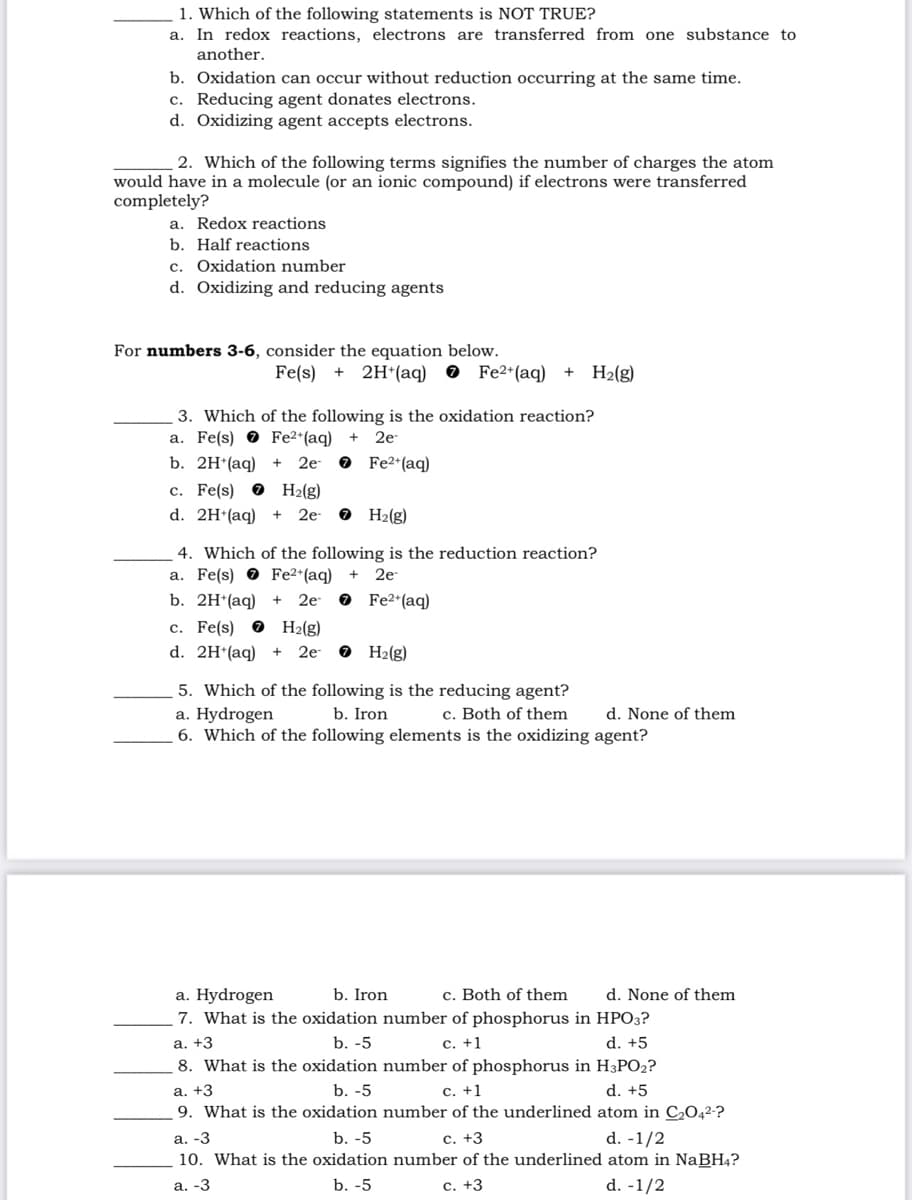1. Which of the following statements is NOT TRUE? a. In redox reactions, electrons are transferred from one substance to another. b. Oxidation can occur without reduction occurring at the same time. c. Reducing agent donates electrons. d. Oxidizing agent accepts electrons. 2. Which of the following terms signifies the number of charges the atom would have in a molecule (or an ionic compound) if electrons were transferred completely? a. Redox reactions b. Half reactions c. Oxidation number d. Oxidizing and reducing agents For numbers 3-6, consider the equation below. Fe(s) + 2H+ (aq) Fe²+ (aq) + H₂(g) 3. Which of the following is the oxidation reaction? a. Fe(s) Fe²+ (aq) + 2e- b. 2H+ (aq) + 2e- Fe²+ (aq) c. Fe(s) H₂(g) d. 2H*(aq) + 2e- H₂(g) 4. Which of the following is the reduction reaction? a. Fe(s) Fe²+ (aq) + 2e- b. 2H*(aq) + 2e Fe²+ (aq) c. Fe(s) H₂(g) d. 2H+(aq) + 2e- H₂(g) 5. Which of the following is the reducing agent? a. Hydrogen b. Iron c. Both of them d. None of them 6. Which of the following elements is the oxidizing agent? a. Hydrogen b. Iron c. Both of them d. None of them 7. What is the oxidation number of phosphorus in HPO₂?
1. Which of the following statements is NOT TRUE? a. In redox reactions, electrons are transferred from one substance to another. b. Oxidation can occur without reduction occurring at the same time. c. Reducing agent donates electrons. d. Oxidizing agent accepts electrons. 2. Which of the following terms signifies the number of charges the atom would have in a molecule (or an ionic compound) if electrons were transferred completely? a. Redox reactions b. Half reactions c. Oxidation number d. Oxidizing and reducing agents For numbers 3-6, consider the equation below. Fe(s) + 2H+ (aq) Fe²+ (aq) + H₂(g) 3. Which of the following is the oxidation reaction? a. Fe(s) Fe²+ (aq) + 2e- b. 2H+ (aq) + 2e- Fe²+ (aq) c. Fe(s) H₂(g) d. 2H*(aq) + 2e- H₂(g) 4. Which of the following is the reduction reaction? a. Fe(s) Fe²+ (aq) + 2e- b. 2H*(aq) + 2e Fe²+ (aq) c. Fe(s) H₂(g) d. 2H+(aq) + 2e- H₂(g) 5. Which of the following is the reducing agent? a. Hydrogen b. Iron c. Both of them d. None of them 6. Which of the following elements is the oxidizing agent? a. Hydrogen b. Iron c. Both of them d. None of them 7. What is the oxidation number of phosphorus in HPO₂?
Chapter5: Chemical Reactions
Section: Chapter Questions
Problem 5.96E
Related questions
Question
Answer 1-5

Transcribed Image Text:1. Which of the following statements is NOT TRUE?
a. In redox reactions, electrons are transferred from one substance to
another.
b. Oxidation can occur without reduction occurring at the same time.
c. Reducing agent donates electrons.
d. Oxidizing agent accepts electrons.
2. Which of the following terms signifies the number of charges the atom
would have in a molecule (or an ionic compound) if electrons were transferred
completely?
a. Redox reactions.
b. Half reactions
c. Oxidation number
d. Oxidizing and reducing agents
For numbers 3-6, consider the equation below.
Fe(s) + 2H+(aq)
Fe2+ (aq) + H₂(g)
3. Which of the following is the oxidation reaction?
a. Fe(s)
Fe2+ (aq) + 2e-
b. 2H+(aq)
+ 2e
Fe²+ (aq)
c. Fe(s)
H₂(g)
d. 2H+ (aq) + 2e
H₂(g)
4. Which of the following is the reduction reaction?
a. Fe(s)
Fe²+ (aq)
2e-
b. 2H+ (aq)
+ 2e
Fe²+ (aq)
c. Fe(s)
H₂(g)
d. 2H+ (aq) + 2e- → H₂(g)
5. Which of the
following is the reducing agent?
a. Hydrogen
b. Iron
c. Both of them
d. None of them
6. Which of the following elements is the oxidizing agent?
a. Hydrogen
b. Iron
c. Both of them d. None of them
7. What is the oxidation number of phosphorus in HPO3?
a. +3
b. -5
c. +1
d. +5
8. What is the oxidation number of phosphorus in H3PO₂?
a. +3
b. -5
c. +1
d. +5
9. What is the oxidation number of the underlined atom in C₂04²-?
a. -3
b. -5
10. What is the oxidation
c. +3
d. -1/2
number of the underlined atom in NaBH4?
c. +3
d. -1/2
a. -3
b. -5
Expert Solution
This question has been solved!
Explore an expertly crafted, step-by-step solution for a thorough understanding of key concepts.
Step by step
Solved in 3 steps

Knowledge Booster
Learn more about
Need a deep-dive on the concept behind this application? Look no further. Learn more about this topic, chemistry and related others by exploring similar questions and additional content below.Recommended textbooks for you


Chemistry for Today: General, Organic, and Bioche…
Chemistry
ISBN:
9781305960060
Author:
Spencer L. Seager, Michael R. Slabaugh, Maren S. Hansen
Publisher:
Cengage Learning

World of Chemistry, 3rd edition
Chemistry
ISBN:
9781133109655
Author:
Steven S. Zumdahl, Susan L. Zumdahl, Donald J. DeCoste
Publisher:
Brooks / Cole / Cengage Learning


Chemistry for Today: General, Organic, and Bioche…
Chemistry
ISBN:
9781305960060
Author:
Spencer L. Seager, Michael R. Slabaugh, Maren S. Hansen
Publisher:
Cengage Learning

World of Chemistry, 3rd edition
Chemistry
ISBN:
9781133109655
Author:
Steven S. Zumdahl, Susan L. Zumdahl, Donald J. DeCoste
Publisher:
Brooks / Cole / Cengage Learning

Chemistry: The Molecular Science
Chemistry
ISBN:
9781285199047
Author:
John W. Moore, Conrad L. Stanitski
Publisher:
Cengage Learning

Chemistry
Chemistry
ISBN:
9781305957404
Author:
Steven S. Zumdahl, Susan A. Zumdahl, Donald J. DeCoste
Publisher:
Cengage Learning

Introductory Chemistry: A Foundation
Chemistry
ISBN:
9781337399425
Author:
Steven S. Zumdahl, Donald J. DeCoste
Publisher:
Cengage Learning